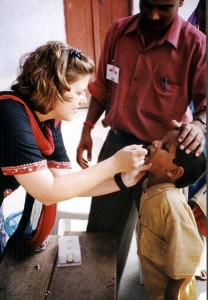For years vaccine manufacturers have been saving money by introducing multi-dose units to administer vaccinations while adding preservatives to prevent contaminations. This way doctors can open and close vaccine containers, which may spread germs to the solution, but the drug companies assure us that those contaminants are quickly killed by the preservative.
The preservative, Thimerosal, introduced in the 1940s, contains 49.6 percent mercury. This is the main ingredients that kills contaminants and according to researchers may be doing us more harm than good. Scientists and the general public know that mercury is toxic, but the question lies in how much mercury-laced thimerosal is toxic and how does it affect our children at low doses.
Eli Lilly and Co., manufacturer of Thimerosal, began tests on the product back in the 1930s and some say the company suppressed important information on the toxicity of thimerosal until now. The drug was banned in many countries more than 20 years ago, yet the United States is still continuing to produce and sell the product. A Russian study found that adults exposed to the form of mercury in thimerosal suffered brain damage years later and some patients developed nervous system injury, coma and death. Because of these findings, Russia banned thimerosal from children’s vaccines in 1980. Denmark, Austria, Japan, Great Britain and all the Scandinavian countries have also banned the preservative.
So how does this affect our children? In 1999, the number of childhood vaccinations rose from 12 to 15 per child and one study revealed that some infants, due to a genetic or developmental factor, lack the ability to eliminate mercury. Trace amounts of mercury in these infants from vaccinations, and then accumulated through multiple vaccinations, could pose a severe health risk. According to The National Vaccine Information Center in Vienna, Virginia, some vaccines such as hepatitis B contained as much as 12.5 micrograms of mercury per dose. That is more than 100 times the EPA’s upper limit standard when administered to infants.
One report by Dr. Vijendra Singh of the Department of Pharmacology at the University of Michigan found a higher incidence of measles, mumps and rubella vaccine (MMR) antibodies in autistic children.
Other groups have also noted the strong association between the MMR vaccine and autistic features. The diphtheria, pertussis and tetanus vaccine given at two, four and six months also triggered autistic symptoms in studies.
Autism affects 500,000 to 1.5 million Americans and has grown at an annual rate of 10 to 17 percent since the late 1980s, according to the National Autism Society of America. Some scientists say the estimated number of cases of autism has increased 15-fold to 1,500 percent since 1991, when the number of childhood vaccinations doubled. Before 1991, one in every 2,500 children were diagnosed with autism. Now one in 166 children has the disease.
In June 2000, federal officials and industry representatives met with the Centers for Disease Control and Prevention to discuss the disturbing evidence. They concluded that thimerosal appeared to be responsible for a dramatic increase in autism and other neurological disorders. Epidemiologist Tom Verstraeten and consultants with the American Academy of Pediatrics, presented similar concerns to the CDC. The CDC and the industry representatives however were quick to discredit the evidence and the data presented was withheld from publication; on the basis that the link between thimerosal and autism remained inconclusive. The FDA said the inconclusive findings negated the risk of a causal relationship between thimerosal and autism.
So despite health organizations admitting to the dangers of thimerosal in vaccinations, and more than 20 countries banning the preservative, thimerosal is still prevalent in our children’s vaccinations in the United States. Many parents filed legal action against the vaccine manufactures and more than 42,000 families have filed lawsuits claiming thimerosal caused injuries to their children.
In 1999, studies began showing that multi-dose vial vaccines, such as the MMR and hepatitis B vaccines contained enough thimerosal to expose vaccinated children to 62.5 ug of mercury per visit. That is one hundred times the dose considered safe by the Federal Environmental Protection Guidelines for infants. Some infants received higher doses if the vaccine was not shaken before being drawn because thimerosal tends to settle in the vial. Thousands of families say they can demonstrate with videos and photos how their children were normal prior to being vaccinated and reacted badly to the vaccines, and then became autistic shortly thereafter.
Today, all childhood vaccines have at least one mercury-free version and parents are urged to ask for those versions to vaccinate their children. As a parent, trust your instincts and talk with your doctor about the potential health hazards of mercury in vaccinations and if your child may be at risk.
Share This



